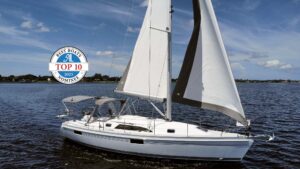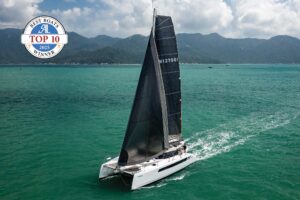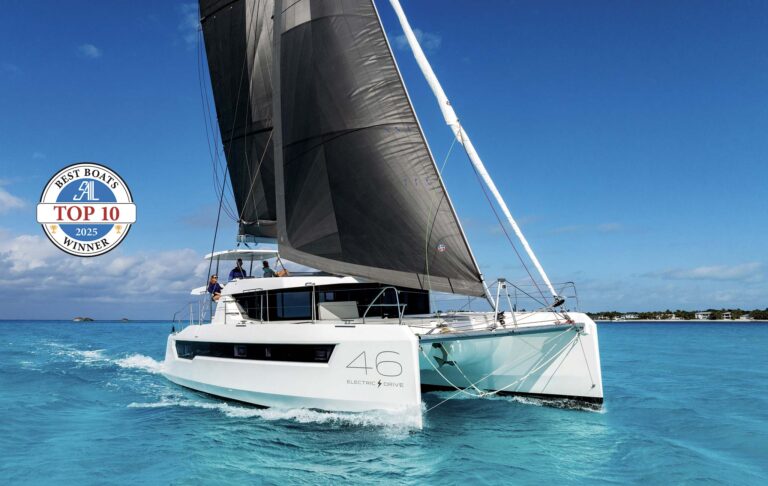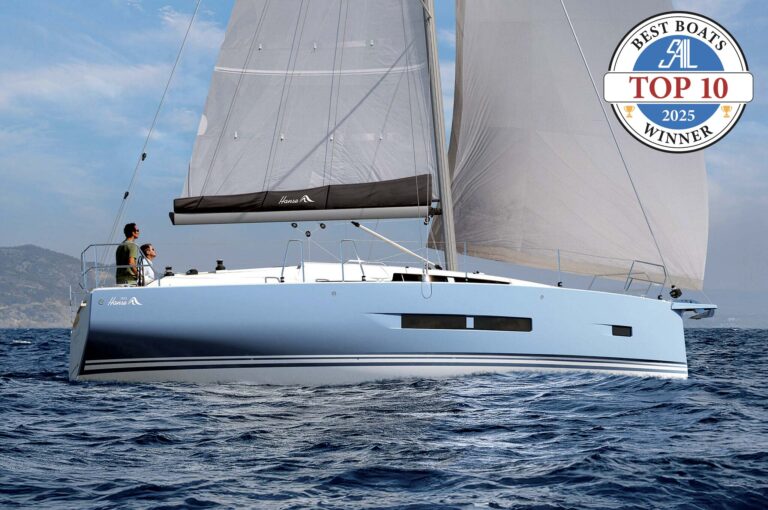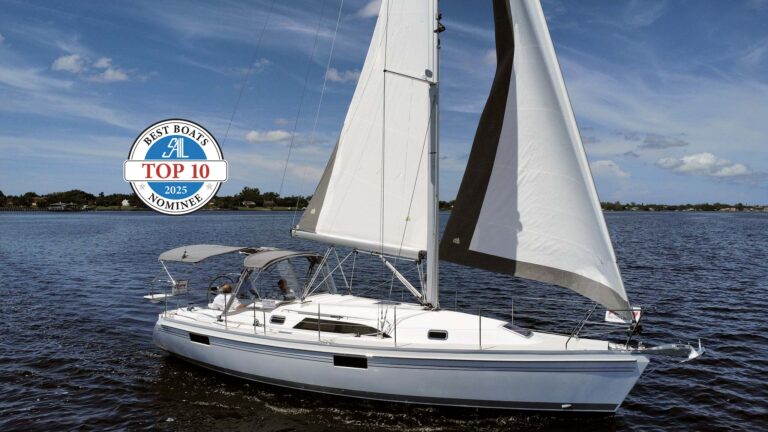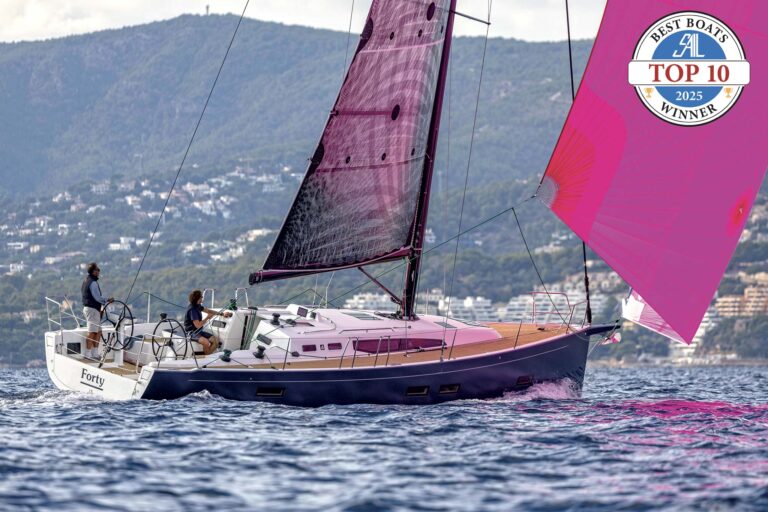
The category of performance cruiser is one that has accommodated everything from stripped-down racers masquerading as weekenders to ice-breakers pretending to be competitive with the help of a generous PHRF rating. The Tartan 4000, though, is a performance cruiser in the truest and best sense of the word—a boat that does well on all points of sail and takes good care of its crew, whether underway or at anchor.
Construction
Like the rest of the Tartan line, the 4000’s hull is vacuum-infused with a foam core and epoxy resin, which yields a strong, yet light glass-resin ratio of 65 percent glass and 35 percent resin (compared to 25 percent glass and 75 percent resin in many non-infused boats). The deck is also resin-infused, with an end-grain balsa core and aluminum backing plates that are inserted into the mold before the resin is added to provide a strong base for winches and other hardware.
The rudder is E-glass wrapped around a carbon-fiber rudderpost. The rig is also carbon fiber—another Tartan standard. The deck is attached to the hull on an inward-turning flange, where it is through-bolted and bonded with 5200 adhesive. A series of molded fiberglass floors are laminated to the hull to help carry rig and keel loads. Three different keels are available, including a deep fin, a shoal-draft fin with a “beavertail” bulb (as on our test boat) and a keel-centerboard combination.
Tartan prides itself on its build quality, which is evident throughout the boat. The company selects choice hardware and the workmanship is first-rate. The result is a boat that is both strong and light at the same time.
On Deck
The twin helm stations aft are cozy without being restrictive, a perfect combination for watch standing at night or relaxing during a daysail. The Tartan 4000 features a drop-down swim step that is raised and lowered with a hefty block and tackle. I’ve been aboard other boats where the gear for raising and lowering a hinged swim step is a bit on the skimpy side, but not on the 4000. The cockpit benches are longer than they look—just long enough for a 6-footer like me to stretch out on—thanks to the boat’s custom-molded carbon steering pedestals, which are open to provide additional legroom.
Moving forward, the 4000’s molded bulwarks, excellent side decks, sturdy handholds, molded nonskid and guardrails protecting a pair of Dorade vents provide a nice sense of security. The foredeck is a good size for working up near the bow, and a beefy anchor roller carries the hook far enough forward to keep the stem safe from the chain and hook.
There’s nothing revolutionary about the deck arrangement; it’s a plan that has been well thought out and well executed. Coupled with the boat’s build quality and the muscular hardware Tartan has specified, the deck is aesthetically pleasing as well.
Accommodations

Belowdecks is more of the same: a good plan well executed. An abundance of varnished cherry results in a “shippy” feel that is both comfortable and attractive: you’d never mistake this saloon for a condo, as you might with some boats currently coming over from Europe. There are handrails everywhere you need them, the wraparound galley has good spots to wedge yourself in when cooking underway, engine access is excellent, and there is plenty of stowage space, including several large hanging lockers.
Tartan goes out of its way to help owners personalize their boats and hull #1 is no exception. According to Tartan’s chief designer, Tim Jackett, who was aboard sea-trialing the new design, the owner of the test boat has a large family. To accommodate them, Tartan installed an extra set of ingenious flip-down sea berths in the saloon. The result is a 40-footer with room not just for four kids, but their friends as well. Talking with Jackett, it’s obvious he welcomes such design challenges and that they are a big part of what makes his job interesting.

Under Sail
It was looking pretty grim as we cast off lines at the McMichael boatyard in Mamaroneck, New York—sunny and warm, but dead calm. Fortunately, motoring out onto Long Island Sound we soon discovered a gentle sea breeze, which prompted us to hoist the full-batten main and unfurl the 155 percent genoa. In no time we were gliding along at 4.5 knots in just over 6 knots of apparent wind. Chasing catspaws, we found a nice little puff, and the boat immediately accelerated to 5 knots in 8.5 knots apparent.
I was sitting behind one of the twin wheels when it occurred to me I couldn’t remember when I’d last touched the helm. Perfectly balanced, the Tartan was more than happy to sail itself while the rest of us did whatever it was that we had to do.
Later, heading back in, we rolled up the genoa, unfurled the self-tacking blade jib on the inner forestay and short-tacked up the channel into Mamaroneck. Once again the 4000 responded wonderfully, coming about decisively and quickly getting back up to speed on each new tack.
When it came time to lower the main, all we did was shoot up into the wind and let go the halyard. The sail came sliding down effortlessly on its Harken Battcar system while the single-line lazy jack system and wide “pocket boom” gathered the sail with ease. For years, Tartan has worked to perfect what it calls its “Cruise Control Rig,” which both performs well and is easy to manage. Granted, the reacher tends to get hung up on the inner forestay when gybing, but that’s a small price to pay for the rig’s inherent flexibility.
Under Power
A bow thruster is an option, but it is definitely a convenience rather than a necessity. With its deep balanced spade rudder and a folding prop on a saildrive unit, the boat maneuvered well in all directions at low speeds and powered up nicely as we motored out to the Sound. The test boat was equipped with an optional 75hp “turbo” engine and a folding four-blade prop, which pushed us along at 6.5 knots at 2,000 rpm. (A 55hp Volvo engine and a three-blade folding prop are standard.) Throttling up to 2,800 rpm yielded 8.3 knots of boat speed. Top speed at 3,2000 rpm was 9.2 knots.

Conclusion
The Tartan 4000 may look like a “traditional” design, but don’t be a fooled simply because it isn’t chasing the latest design fads. It is, in fact, a very modern boat that incorporates much of what is best from across the design and boatbuilding world. The result is a fine yacht that is a pleasure to be aboard, no matter what kind of sailing you do.
Specifications:
HEADROOM 6ft 5in
BERTHS 6ft 6in x 5ft 4in (fwd); 6ft 6in x 4ft 8in (aft)
LOA 40ft 8in
LWL 36ft 5in
BEAM 13ft
DRAFT 7ft 6in (deep keel); 5ft 11in (shoal) 4ft 9in (centerboard up)
DISPLACEMENT 19,604lb (deep keel) 20,104lb (shoal); 21,104lb (centerboard)
BALLAST 6,400lb (deep keel); 8,000lb (shoal); 8,600lb (centerboard)
SAIL AREA 890ft2 (main and self-tacking jib)
FUEL/WATER/WASTE (GAL) 50/100/20
ENGINE 55hp Volvo saildrive
ELECTRICAL 90AH (engine); 2 x 220AH (house)
DESIGNER Tim Jackett
BUILDER Tartan Yachts, Painesville, OH, 440-357-7777, tartanyachts.com
PRICE $450,000 (sailaway)
Ballast Ratio: 33
Sail Area-Displacement Ratio: 20
Displacement-Length Ratio: 181

